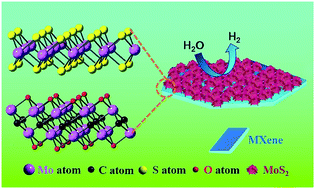2D organ-like molybdenum carbide (MXene) coupled with MoS2 nanoflowers enhances the catalytic activity in the hydrogen evolution reaction†
Abstract
Two-dimensional molybdenum carbides belong to a novel family of 2D transition metal carbides/nitrides called MXenes, which have a wide range of electrochemical applications. However, the synergistic catalysis of transition metal carbides and disulfides has not been studied in depth. A strategy was proposed to prepare a 2D organ-like Mo2C MXene matrix derived from Mo2Ga2C crystals, coupled with MoS2 nanoflowers to explore the hydrogen evolution reaction (HER) of molybdenum carbides and disulfides. Compared with Mo2CTx (where Tx means F, O, and OH surface terminations) Mxene catalysts, MoS2@Mo2CTx nanohybrids showed significantly enhanced HER activity, with a low overpotential of 176 mV in alkaline media at a current density of 10 mA cm−2 and a very small overpotential of 26 Ω. Density functional theory calculations indicated that the reduction of the hydrogen adsorption energy of the MoS2@Mo2CTx nanohybrids could be attributed to fast electron transport ensured by Mo2CTx with intrinsic conductivity and a large number of hydrogen adsorption sites provided by MoS2 nanoflowers. The synthetic method is promising to tailor the specific properties by preparing organ-like molybdenum carbides coupled with MoS2 nanoflowers.



 Please wait while we load your content...
Please wait while we load your content...